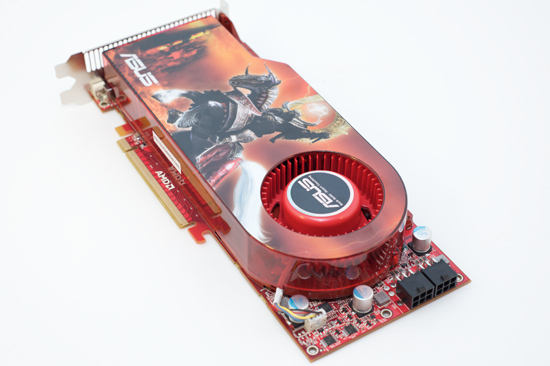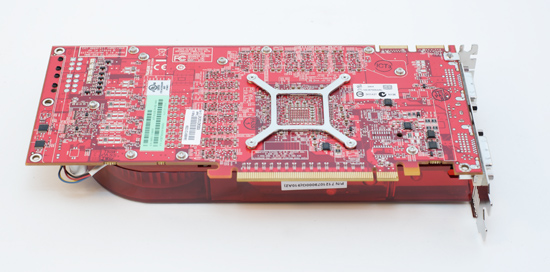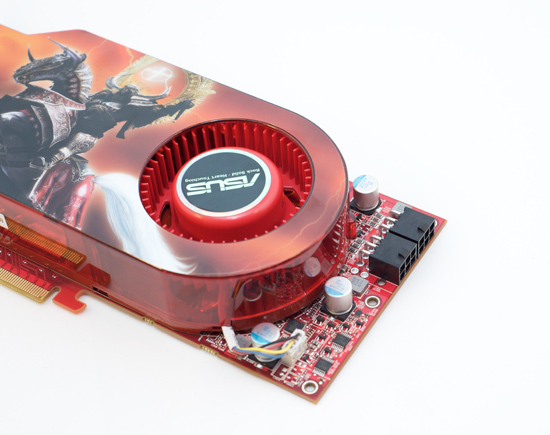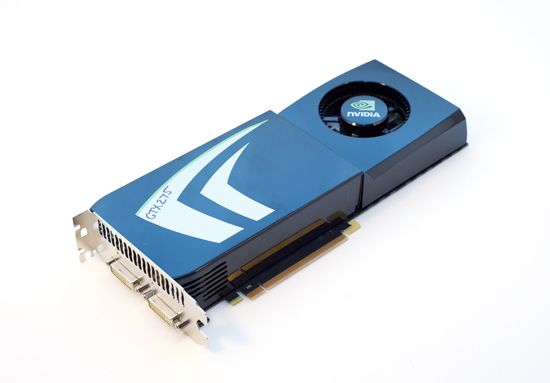ATI Radeon HD 4890 vs. NVIDIA GeForce GTX 275
by Anand Lal Shimpi & Derek Wilson on April 2, 2009 12:00 AM EST- Posted in
- GPUs
The Cards and The Test
In the AMD department, we received two cards. One was an overclocked part from HIS and the other was a stock clocked part from ASUS. Guess which one AMD sent us for the review. No, it's no problem, we're used to it. This is what happens when we get cards from NVIDIA all the time. They argue and argue for the inclusion of overclocked numbers in GPU reviews when it's their GPU we're looking at. Of course when the tables are turned so are the opinions. We sincerely appreciate ASUS sending us this card and we used it for our tests in this article. The original intent of trying to get a hold of two cards was to run CrossFire numbers, but we only have one GTX 275 and we would prefer to wait until we can compare the two to get into that angle.



The ASUS card also includes a utility called Voltage Tweaker that allows gamers to increase some voltages on their hardware to help improve overclocking. We didn't have the chance to play with the feature ourselves, but more control is always a nice feature to have.

For the Radeon HD 4890 our hardware specs are pretty simple. Take a 4870 1GB and overclock it. Crank the core up 100 MHz to 850 MHz and the memory clock up 75 MHz to 975 MHz. That's the Radeon HD 4890 in a nutshell. However, to reach these clock levels, AMD revised the core by adding decoupling capacitors, new timing algorithms, and altered the ASIC power distribution for enhanced operation. These slight changes increased the transistor count from 956M to 959M. Otherwise, the core features/specifications (texture units, ROPs, z/stencil) remain the same as the HD4850/HD4870 series.
Most vendors will also be selling overclocked variants that run the core at 900 MHz. AMD would like to treat these overclocked parts like they are a separate entity altogether. But we will continue to treat these parts as enhancements of the stock version whether they come from NVIDIA or AMD. In our eyes, the difference between, say, an XFX GTX 275 and an XFX GTX 275 XXX is XFX's call; the latter is their part enhancing the stock version. We aren't going to look at the XFX 4890 and the XFX 4890 XXX any differently. In doing reviews of vendor's cards, we'll consider overclocked performance closely, but for a GPU launch, we will be focusing on the baseline version of the card.
On the NVIDIA side, we received a reference version of the GTX 275. It looks similar to the design of the other GT200 based hardware.

Under the hood here is the same setup as half of a GTX 295 but with higher clock speeds. That means that the GTX 275 has the memory amount and bandwidth of the GTX 260 (448-bit wide bus), but the shader count of the GTX 280 (240 SPs). On top of that, the GTX 275 posts clock speeds closer to the GTX 285 than the GTX 280. Core clock is up 31 MHz from a GTX 280 to 633 MHz, shader clock is up 108 MHz to 1404 MHz, and memory clock is also up 108 MHz to 2322. Which means that in shader limited cases we should see performance closer to the GTX 285 and in bandwicth limited cases we'll still be faster than the GTX 216 because of the clock speed boost across the board.
Rather than just an overclock of a pre-existing card, this is a blending of two configurations combined with an overclock from the two configurations from which it was born. And sure, it's also half a GTX 295, and that is convenient for NVIDIA. It's not just that it's different, it's that this setup should have a lot to offer especially in games that aren't bandwidth limited.
That wraps it up for the cards we're focusing on today. Here's our test system, which is the same as for our GTS 250 article except for the addition of a couple drivers.
The Test
| Test Setup | |
| CPU | Intel Core i7-965 3.2GHz |
| Motherboard | ASUS Rampage II Extreme X58 |
| Video Cards | ATI Radeon HD 4890 ATI Radeon HD 4870 1GB ATI Radeon HD 4870 512MB ATI Radeon HD 4850 NVIDIA GeForce GTX 285 NVIDIA GeForce GTX 280 NVIDIA GeForce GTX 275 NVIDIA GeForce GTX 260 core 216 |
| Video Drivers | Catalyst 8.12 hotfix, 9.4 Beta for HD 4890 ForceWare 185.65 |
| Hard Drive | Intel X25-M 80GB SSD |
| RAM | 6 x 1GB DDR3-1066 7-7-7-20 |
| Operating System | Windows Vista Ultimate 64-bit SP1 |
| PSU | PC Power & Cooling Turbo Cool 1200W |










294 Comments
View All Comments
SiliconDoc - Monday, April 6, 2009 - link
Yes, exactly why added value of CUDA, PhysX, badaboom, vReveal, the game profiles ready in nv panel, the forced SLI, the ambient occlusion games and their MODS ( se back a page or two in comments) - all MATTER to a lot gamers.Let's not forget card size for htpc'ers - heat, dissipation, H.264 etc.
Just the frames matter here just for ati - formerly at 2560x when ati had that crown, now of course, just for lower resolutions - the most important suddenly to the same reviewers, when ati is stuck down there.
Yeah, PATHETIC describes the dismissal of added values.
Flunk - Thursday, April 2, 2009 - link
I have a CUDA-supporting GPU (8800GTS) and I have rarely used it. Other than to run the CUDA version of folding at home (there is also an Ati Stream version) or to look at the preitty effects in a few games. I don't really think these effects are particularly worthwhile and unless the industry comes together and supports a standard like OpenCL I don't see GPU-based processing becoming important to most uses.SiliconDoc - Monday, April 6, 2009 - link
Here's a clue as to why you're already WRONG.Most "gpu users" use NVidia. DUH.
So while you're whistling in the dark, it's already past that time when your line of crap has any basis in reality.
It takes a gigantic red fanboy brain fart to state otherwise.
Oh well, since when did facts matter when the red plague is rampant?
Hrel - Thursday, April 2, 2009 - link
You can get an Nvidia GPU that runs CUDA and Badaboom for $50; the 9600GT. End of page 13.Hrel - Thursday, April 2, 2009 - link
You can get an Nvidia GPU that runs CUDA and Badaboom for $50; the 9600GT.punjabiplaya - Thursday, April 2, 2009 - link
Just need to some stable OC vs OC results!SiliconDoc - Monday, April 6, 2009 - link
anand doesn't do the overclocked part comparison of the videocard wars - BUT DON 'T worry - a red rooster exception with charts and babbling is no doubt coming down the pike.Keep begging, then they can "respond to customer demands". lol
Oh man, this is going to be fun.
I suggest they start with the gainward gtx260 overclock goes like hell, that whips every single 4870 1g XXX ever made. Sound good ?
Griswold - Thursday, April 2, 2009 - link
What I'm really curious about because neither of the cards is what I'm interested in buying, but I like to follow both companies business strategies:Does nvidia really lose money or is looking at a fat zero on the bottom line with this card?
SiliconDoc - Monday, April 6, 2009 - link
Uhh ati is losing a billion a year.If you want card specifics, that's probably difficult to calculate - and loss leaders are nothing new in business - in fact that's what successful businesses use as a sales tool. Seems ATI has taken it a bit too far and made every card they sell a loss leader, hence their billions in the hole.
Now as far as the NVidia card in question, even if Obama takes over the mean greedy green machine - he and his cabal "won't release the information because it's just not fair and may cause those not really needing help at the money window to be expsoed".
So no, you won't be finding out.
The problem is anyway, if a certain card is a loss leader, they calculate how much other business it brings in, and that makes it a WINNER - and that's the idea.
flashbacck - Thursday, April 2, 2009 - link
The physx/cuda section was interesting, although it sounded a bit... whiny.I would LOVE it if someone would write an article about all the PR and marketing shenanigans that go on with reviewers behind the scenes. It'll never happen because it would kill any relationship the author has with the companies, but I bet it would be an eye opening read.